A mass for asymptotically complex hyperbolic manifolds
A mass for asymptotically complex hyperbolic manifolds
A mass for asymptotically complex hyperbolic manifolds
You also want an ePaper? Increase the reach of your titles
YUMPU automatically turns print PDFs into web optimized ePapers that Google loves.
hal-00429306, version 1 - 2 Nov 2009<br />
A MASS FOR ASYMPTOTICALLY COMPLEX HYPERBOLIC MANIFOLDS. 15<br />
Proof. The definition g0 = g(A,A) and the compatibility of J with g0 yield the equality<br />
g(AJ,AJ) = g(A,A). Since A and J are respectively g-symmetric and g-antisymmetric,<br />
we deduce : JA 2 J = −A 2 . If A = 1 + H, this implies JHJ ≈ −H. Since J 2 = −1, we<br />
obtain JH ≈ HJ and then JA ≈ AJ, hence the result. <br />
Corollary 3.5 — We have cg(Ω) ≈ cg0 (Ω0) and π Ω k<br />
≈ πΩ0<br />
k .<br />
Proof. Given a g0-orthonormal basis (e1,Je1,...,em,Jem), the Clif<strong>for</strong>d action of the<br />
Kähler <strong>for</strong>m Ω0 reads cg0 (Ω0) = <br />
k Jek · ek· while the Kähler <strong>for</strong>m Ω of g acts by<br />
m<br />
m<br />
cg(Ω) = cg(JAek)cg(Aek) = (A −1 JAek) · ek · .<br />
k=1<br />
The first statement is there<strong>for</strong>e a straight<strong>for</strong>ward consequence of lemma 3.4. The<br />
second one follows from general considerations. We observe the skew-Hermitian endomorphisms<br />
P := cg(Ω) and P0 := cg0 (Ω0) act on each fiber of the spinor bundle with<br />
the same spectrum. If λ is one of the eigenvalues, the corresponding spectral projectors<br />
Π and Π0 (<strong>for</strong> P and P0) obey the <strong>for</strong>mulas<br />
Π = 1<br />
2π<br />
<br />
C<br />
k=1<br />
(z − P) −1 dz and Π0 = 1<br />
2π<br />
<br />
C<br />
(z − P0) −1 dz<br />
where C is a circle in the <strong>complex</strong> plane, centered in λ and with small radius δ. We<br />
deduce<br />
Π − Π0 = 1<br />
<br />
(z − P)<br />
2π C<br />
−1 (P − P0)(z − P0) −1 dz<br />
and then<br />
|Π − Π0| ≤ δδ −1 |P − P0|δ −1 = δ −1 |P − P0|.<br />
The result follows at once. <br />
The rest of this section is devoted to the proof of the following statement.<br />
Proposition 3.6 — The “<strong>mass</strong> integral at infinity” is<br />
<br />
<br />
lim ∗ζψ,ψ = lim ∗ −<br />
R→∞<br />
R→∞<br />
1<br />
4 (dTrg0 g + divg0 g) |φ|2 + 1<br />
8 Trg0 (g − g0) d |φ| 2<br />
<br />
.<br />
SR<br />
SR<br />
Proof. To begin with, in view of corollary 3.5, we may write<br />
ζφ,φ(Y ) = ( ˆ ∇ g<br />
Y φ + cg(Y ) ˆ Dφ,φ) − i(m + 1) cg(Y )(1 − π Ω l−1 − πΩ l )φ,φ<br />
≈ ( ˆ ∇ g<br />
Y φ + cg(Y ) ˆ Dφ,φ).<br />
Given a g0-orthonormal frame (e1,... ,e2m) and a g0-unit vector X, since φ is a<br />
Kählerian Killing spinor with respect to (g0,J0), we may there<strong>for</strong>e write outside K<br />
(as in [CH, Min] <strong>for</strong> instance) :<br />
ζφ,φ(AX) ≈ 1<br />
2<br />
≈ 1<br />
2<br />
≈ 1<br />
2<br />
2m<br />
j=1<br />
2m<br />
j=1<br />
2m<br />
j=1<br />
([cg(AX),cg(Aej)] ˆ ∇ g<br />
Aej φ,φ)<br />
([cg(AX),cg(Aej)]( ˆ ∇ g<br />
Aej − ˆ ∇ g0<br />
Aej )φ,φ)<br />
([X·,ej·]( ˆ ∇ g<br />
Aej − ˆ ∇ g0<br />
Aej )φ,φ),


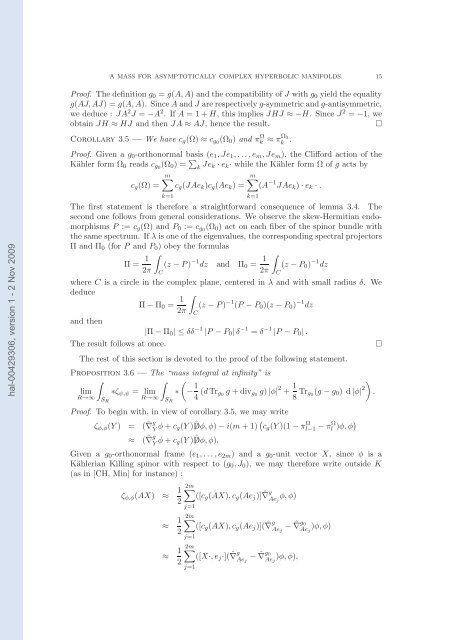

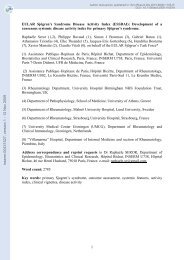
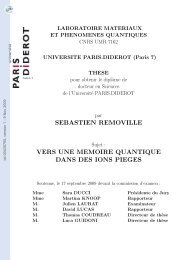
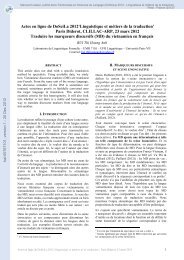
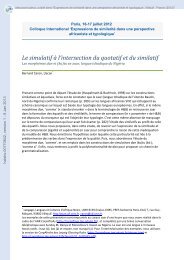
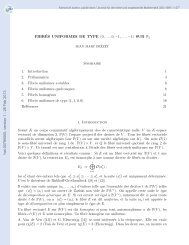
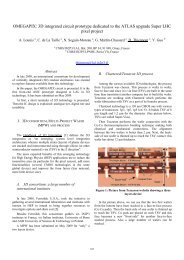
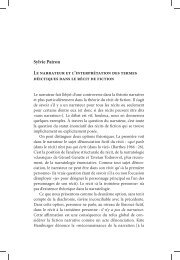
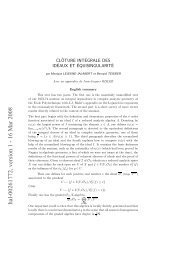
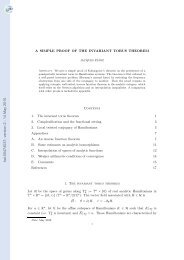

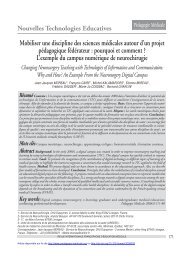

![[tel-00433556, v1] Relation entre Stress Oxydant et Homéostasie ...](https://img.yumpu.com/19233319/1/184x260/tel-00433556-v1-relation-entre-stress-oxydant-et-homeostasie-.jpg?quality=85)